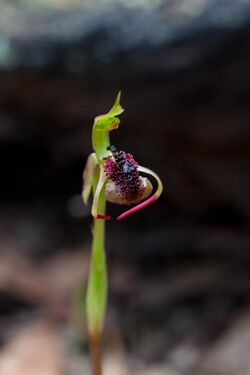Biology:Chiloglottis trilabra
| Long-clubbed wasp orchid | |
|---|---|

| |
| Scientific classification Error creating thumbnail: Unable to save thumbnail to destination
| |
| Kingdom: | Plantae |
| Clade: | Tracheophytes |
| Clade: | Angiosperms |
| Clade: | Monocots |
| Order: | Asparagales |
| Family: | Orchidaceae |
| Subfamily: | Orchidoideae |
| Tribe: | Diurideae |
| Genus: | Chiloglottis |
| Species: | C. trilabra
|
| Binomial name | |
| Chiloglottis trilabra Fitzg.[1]
| |
| Synonyms[1] | |
| |
Chiloglottis trilabra, commonly known as the long-clubbed wasp orchid,[2] is a species of orchid endemic to south-eastern Australia . It has two dark green leaves and a single greenish brown or pinkish flower with a dark red to black, ant-like callus covering most of the upper surface of the labellum. It is similar to both C. seminuda and C. reflexa.
Description
Chiloglottis trilabra is a terrestrial, perennial, deciduous, herb with two dark green, oblong to egg-shaped leaves 20–50 mm (0.8–2 in) long and 10–15 mm (0.4–0.6 in) wide. A single greenish brown or pinkish flower 25–32 mm (0.98–1.3 in) long and 6–7 mm (0.2–0.3 in) wide is borne on a flowering stem 50–100 mm (2–4 in) high. The dorsal sepal is spatula-shaped, 13–16 mm (0.5–0.6 in) long and 2.5–4 mm (0.1–0.2 in) wide. The lateral sepals are linear, 15–18 mm (0.6–0.7 in) long, less than 1 mm (0.04 in) wide and curve downwards. There is a glandular tip 2–3 mm (0.08–0.1 in) long on the dorsal sepal, dark red and 3–5 mm (0.1–0.2 in) long on the lateral sepals. The petals are oblong to lance-shaped, 9–11 mm (0.35–0.43 in) long, about 3 mm (0.1 in) wide and turned downwards towards the ovary. The labellum is more or less horizontal, diamond-shaped, 9–11 mm (0.35–0.43 in) long and 6–7 mm (0.2–0.3 in) wide with a black, ant-like callus surrounded by many stalked and stalkless glands occupying most of its upper surface. The column has narrow wings. Flowering occurs from December to March.[2][3][4]
This wasp orchid is similar to C. seminuda which has a callus covering only about two-thirds of the labellum. It is also similar to C. reflexa but has longer lateral sepals and a smaller "head" on the ant-like callus.[4][5]
Taxonomy and naming
Chiloglottis trilabra was first formally described in 1883 by Robert D. FitzGerald and the description was published in Journal of Botany, British and Foreign from a specimen "obtained on Mount York in the Blue Mountains".[6][7] The specific epithet (trilabra) is derived from the Latin prefix tri- meaning "three"[8]:813 and labra meaning "lip".[8]:487 The type specimen happened to be an aberrant form having two extra labellums in place of two lateral sepals.[5][9]
Distribution and habitat
The long-clubbed wasp orchid is widespread in moist parts of forest, mainly on the ranges in New South Wales. In Victoria it is only known from a few areas in the east, but may be more widespread because it has been confused with C. seminuda and C. reflexa.[2][3][4]
References
- ↑ 1.0 1.1 "Chiloglottis trilabra". World Checklist of Selected Plant Families (WCSP). Royal Botanic Gardens, Kew. http://wcsp.science.kew.org/namedetail.do?name_id=38989.
- ↑ 2.0 2.1 2.2 Jones, David L. (2006). A complete guide to native orchids of Australia including the island territories. Frenchs Forest, N.S.W.: New Holland. p. 141. ISBN 1877069124.
- ↑ 3.0 3.1 Jones, David L.. "Chiloglottis trilabra". Royal Botanic Garden Sydney. http://plantnet.rbgsyd.nsw.gov.au/cgi-bin/NSWfl.pl?page=nswfl&lvl=sp&name=Chiloglottis~trilabra.
- ↑ 4.0 4.1 4.2 Jeanes, Jeff; Stajsic, Val. "Chiloglottis trilabra". Royal Botanic Gardens Victoria. https://vicflora.rbg.vic.gov.au/flora/taxon/de38dd1c-b6d9-4f0a-8231-a43aafa562a5.
- ↑ 5.0 5.1 MacDonald, Margaret. "Chiloglottis trilabra or Chiloglottis reflexa?". Anglesea, Aireys Inlet Society for the Protection of Flora and Fauna). http://angair.org.au/2-uncategorised/658-chiloglottis-trilabra-or-chiloglottis-reflexa.
- ↑ "Chiloglottis trilabra". APNI. https://id.biodiversity.org.au/instance/apni/471643.
- ↑ Fitzgerald, Robert D. (1883). "New Australian orchids". Journal of Botany, British and Foreign 21: 204. https://www.biodiversitylibrary.org/page/35393391#page/215/mode/1up. Retrieved 24 April 2018.
- ↑ 8.0 8.1 Brown, Roland Wilbur (1956). The Composition of Scientific Words. Washington, D.C.: Smithsonian Institution Press.
- ↑ Bishop, Tony (2000). Field guide to the orchids of New South Wales and Victoria (2nd ed.). Sydney: UNSW Press. p. 120. ISBN 0868407062.
External links
Wikidata ☰ Q52153555 entry
 |

